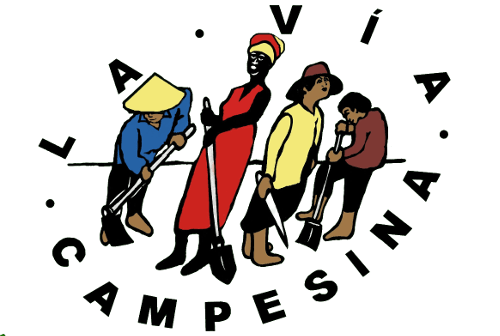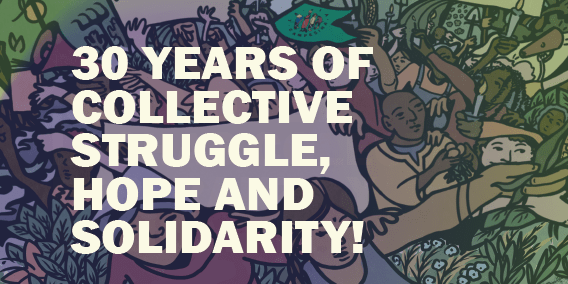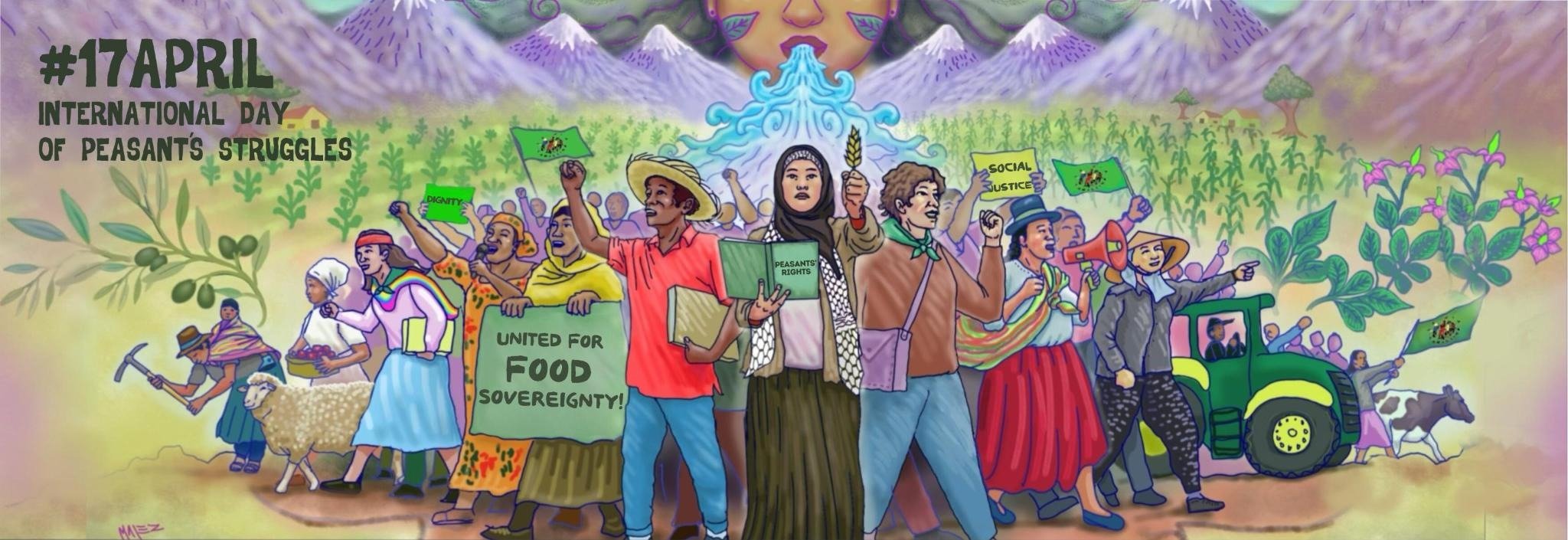Background document – La Via Campesina
30 November 2010
A new global economic order is emerging with agriculture—specifically biomass—as its nexus. Policymakers and corporate executives refer to the new “bioeconomy,” claiming that humanity can transition from a global economy based on fossil fuels to one based on biomass from agricultural crops, forests and algae. Touted as “clean,” “green” “renewable” and “sustainable,” the false solutions being proposed by governments and transnational corporations in response to the climate, energy and food crises are propelling the expansion of the bioeconomy. Yet beneath these claims, the bioeconomy is facilitating the expansion of industrial agriculture, and vertical integration and market consolidation for agribusiness transnational corporations (TNCs).
The United Nations Framework Convention on Climate Change (UNFCCC) is rapidly becoming a platform to legitimize, regulate and expand the bioeconomy. Big Grain, Big Biotech and Big Forestry TNCs benefit from the increasing number, scope and percentage of agricultural methodologies approved by the UNFCCC for carbon emissions offsets, carbon sequestration and adaptation to climate change. Yet instead of reducing greenhouse gas emissions and stabilizing the climate, the false solutions to the climate crisis provide new ways for TNCs to expand and consolidate control of seeds, lands, water and forests, and therefore pose serious threats to farmers, indigenous peoples, fisherfolk and rural workers.
The false solutions to the climate crisis are based on myths, specifically that of limitless, renewable biomass. Even so-called renewable resources, for example, agricultural crops for agrofuels, depend on finite resources such as geographic land area, soil nutrients and fresh water. Thus we are told that biotechnology will solve the problem of finite resources. Many of the false solutions being proposed within the UNFCCC draw on the myths above and integrate others, in particular that the same economic model—indeed the same TNCs—that created the climate crisis will now be the solution to the crisis through the carbon credit market. The carbon credit market is also predicated on myths, specifically that all greenhouse gas emissions, everywhere, can be regulated and controlled by a single, complex global system that is managed by the same financiers and corporations that created the climate crisis. The carbon credit market is founded on several mythical mechanisms:
• Through the implementation of the Clean Development Mechanism (CDM), industrialized countries and TNCs in the Global North can continue to emit the same amount of greenhouse gasses at the same rate and still meet their required emissions reductions by funding CDM projects, most of which are in developing countries in the Global South.
• Carbon offsets, based on a system of cap and trade, are when a polluting TNC purchases credits for reducing, avoiding, or sequestering emissions occurring elsewhere, instead of reducing emissions at the source.
• Carbon sequestration holds that emissions can continue as long as the same amount of emissions are sequestered elsewhere. The Intergovernmental Panel on Climate Change considers soil carbon sequestration to offer the greatest potential for climate change mitigation in agriculture. According to Wikipedia, sequestration is the process of removing carbon from the atmosphere and depositing it in a reservoir. It is a geoengineering technique for long-term storage of carbon dioxide.(1) Sequestration is problematic because its methodologies (biochar, forest preservation sinks, etc) depend on a continuous model of land use for a particular area, for example, that land where biochar has been buried will never be plowed or developed. It also creates an excuse for polluters to keep polluting at the source, claiming that their emissions are being sequestered elsewhere.
• Described as potentially the ‘largest land grab of all time,’ Reducing Emissions from Deforestation and Forest Degradation (REDD) places forests (and agricultural land, if we consider REDD +) directly into the carbon market for the benefit of TNCs. REDD allows polluting TNCs to buy their way out of reducing their greenhouse emissions at source by supposedly conserving forests. However, according to the Indigenous Environmental Network, REDD is rife with “perverse incentives” to convert natural forests into monoculture tree plantations and to actually increase deforestation.
Until now, a low percent of CDM funding has gone to agricultural practices (not including energy production from waste biomass), though this number is increasing as more methodologies for sequestration and offsets are approved. According to the UNFCCC web site, agriculture represents just 2.58 percent of approved methodologies, while aforestation and reforestation represent 9.28 percent of approved methodologies. This does not include methodologies for energy production that utilizes biomass and waste biomass.(2) Agriculture represents 4.38 percent (128 projects) of all registered CDM projects, while aforestation and reforestation represent .58 percent (17 projects). Most agricultural methodologies are focused on reducing emissions from industrial meat production facilities, as opposed to requiring more sustainable models of production (i.e., small-scale) that would generate fewer emissions.
Agrofuels: Until recently, agrofuels production was not an approved CDM methodology, yet energy production from waste biomass was. For example, Cabrera Central Energética Açucar e Álcool Ltda., a Brazilian subsidiary of Archer Daniels Midland and Grupo Cabrera, has a CDM project to generate electricity from waste bagasse from its ethanol plant. In October 2009, the CDM Board approved a methodology for biodiesel production from dedicated plantations on ‘degraded or degrading land’, a definition so wide that it covers most agricultural soils and many natural ecosystems. This methodology allows large agrofuel producers such as Archer Daniels Midland and Cargill to directly benefit from carbon credits for the first time. Any CDM methodology that entails energy production from crops, be it waste residues or production of agrofuels, will benefit the biotechnology TNCs, which are genetically-engineering micro-organisms and enzymes with the goal to reduce the energy required to break down biomass into agrofuels, increase cellulose biomass from crop waste and residues (e.g. corn stover, eucalyptus), and change the ratio of lignin to cellulose in biomass so that it can be converted into products such as agrofuels and bioplastics. According to Syngenta, “agriculture has the potential to reduce greenhouse gases through the production of crops for biofuels, a lower-carbon alternative to fossil fuels.” Any CDM project that encourages industrial agrofuels producers to gain carbon credits, whether from biomass waste or direct production of agrofuels, presents serious threats to farmers, as it encourages land grabbing and speculation by foreign investors, degradation of lands, biodiversity and water with chemicals and monoculture production, and increasing the market power of TNCs.
Genetically-engineered, climate-ready crops: Crops that are genetically-engineered to withstand drought, heat, cold, flood and salt are being promoted by biotechnology TNCs as necessary to adapt to climate change. The advancement of GE climate-ready crops further threatens farmers’ rights to seed agrobiodiversity through patent claims and genetic contamination. According to ETC Group, under the guise of developing ‘climate-ready’ crops, TNCs are pressuring governments to allow what could become the broadest and most dangerous patent claims in intellectual property history. The aim of plant breeding is no longer only to feed people, but to maximize biomass for agrofuels, bioplastics, etc. Just six corporations (DuPont, BASF, Monsanto, Syngenta, Bayer and Dow) control 77 percent of the 262 patent families (both issued patents and applications) published between June 2008 and June 2010 for climate-ready crops. Three companies – DuPont, BASF and Monsanto – account for 66 percent. The public sector has only 9 percent. DuPont alone accounts for 44 percent, while Monsanto accounts for 4 percent.
Chemical no-till agriculture: Although not yet approved, another methodology in the pipeline for carbon sequestration is chemical no-till agriculture (also called ‘conservation’ and ‘sustainable agriculture’ by the TNCs), based on the premise that agricultural emissions can be reduced by not tilling the soil, thereby sequestering carbon dioxide. Monsanto has been lobbying since 1998 for no-till agriculture to be an approved CDM methodology, and it is already recognized by the Chicago Climate Exchange. Monsanto claims its GE Roundup Ready crops help tackle climate change because they can be grown without tilling weeds into the soil, instead dowsing them with massive quantities of Roundup herbicide (glyphosate). If farmers that grow Roundup-Ready crops can access offset credits for the no-till methodology, sales of Monsanto’s seeds will increase as will sales of its chemicals, as countries will encourage more large-scale farmers to plant Roundup Ready crops to qualify for carbon credits. In 2009 Monsanto won the Angry Mermaid award for its lobbying efforts to have chemical no-till agriculture and Roundup Ready soybean plantations approved by the UNFCCC. If chemical no-till agriculture is approved, industrial monocultures and their attendant use of GE crops and toxic chemicals will increase, further displacing rural communities from their lands, concentrating landholdings in the hands of TNCs, and poisoning water and human bodies with chemicals.
Nitrogen inoculation of legumes: In July 2009, UNFCCC approved the first agricultural production methodology for CDM, based on a technology that eliminates the use of nitrogen fertilizers on legumes by treating seeds with nitrogen-fixing bacteria. The methodology was created for use on industrial monocultures of soybean and maize rotations, and is based on a technology patented by Becker Underwood Inc., which developed the technology with Amson Technology LLC and Perspectives GmbH for a CDM project in Brazil. In 2008, Monsanto entered into a partnership with Becker Underwood to develop technologies for proprietary seed treatments for corn, soybeans and cotton. Monsanto has been offering nitrogen seed treatments since 2009 and all Roundup Ready 2 Yield soybeans are treated with this nitrogen-fixing bacteria. Monsanto is working to have seed treatments for Deltapine cotton and for SmartStax corn. This methodology is problematic because it encourages the expansion of chemical-intensive monoculture production of GMOs, controlled by TNCs.
Industrial Tree Plantations: Under the guise of ‘aforestation and reforestation’, industrial tree plantations for the production of cellulosic agrofuels and production of bioplastics are being promoted as ‘forests’ that sequester carbon. Yet plantations are not forests, and native forests sequester much more carbon dioxide than tree plantations, and they generate biodiversity, versus the green deserts of eucalyptus plantations. As forestry and paper companies such as Stora Enso, Weyerhauser, Votarantim and Kimberly Clark access carbon credits under aforestation and reforestation methodologies, their plantations will expand, threatening the territories of indigenous and traditional communities, and further threatening forests and the biodiversity and water systems within them. Current proposals in REDD would aid the agrofuels industry by subsidising the conversion of primary forests to industrial oil palm and other tree and shrub plantations (including jatropha) under the guise of ‘forests’.
Hydropower dams: Hydropower dams are being promoted by the UNFCCC clean energy. Yet dams are significant sources of greenhouse gas emissions. Further, they flood territories, lands and forests that sequester carbon. Hydropower dams pose significant threats to peasants and indigenous peoples’ territories and fisheries, and can also work to encourage settlement—and degradation—of forests. For example, through its holdings in Ecosecurities, Cargill helped to fund a series of hydropower dams in several Amazonian states of Brazil, which also happen to be where soybean cultivation is greatly expanding. Ecosecurities’ carbon calculation did not have to take into account deforestation caused from further settlement of the region, which may have been encouraged by construction of the dams. Almost all of the dams projects funded by Ecosecurities in Brazil were located close to major highways that connected soybean and meat producers with processors and Cargill’s soybean exporting facility on the Amazon River.
Methane capture from factory farms: ADM and Cargill access CDM credits with projects for emissions reduction through livestock manure management (including biogas production from swine manure), heat generation from palm oil mill effluents, and the use of agricultural residues for agrofuels (corn stover and sugarcane bagasse). In 2007, 90% of all approved CDM projects in Malaysia benefited palm oil companies. In Mexico, half of all CDM projects involved pig farms. Cargill and ADM control 50% of palm oil production in Asia, and Cargill is a major player in Mexican pork production.
Biochar: Proponents of biochar claim that applying charcoal to soils will create reliable and permanent carbon sinks, as well as make soils more fertile and water retentive. Proposals entail planting from 500 million to over one billion hectares of industrial tree plantations, burning them, and burying the resulting charcoal in soils. Perhaps with the exception of agrofuels, soil carbon sequestration for carbon offsets through biochar and chemical no-till agriculture are touted as having the most potential for carbon capture among the agriculture methodologies, provided that its exclusion from the CDM is lifted. According to Biofuelwatch, no biochar methodology has been approved by the CDM board yet, but a charcoal methodology was approved that could easily be adapted for biochar. The proposed methodology was initiated by Plantar, a company with extensive eucalyptus plantations in Minas Gerais, Brazil. Of particular worry is how Arborgen, which develops genetically-engineered eucalyptus, would benefit from an approved methodology for biochar.
A closer look at how TNCs are benefitting from the carbon market
Carbon trading is now the fastest-growing commodities market on earth. Since 2005 there have been more than $300 billion worth of carbon transactions. The world’s largest financial institutions such as Goldman Sachs, Barclays and Citibank now host carbon trading desks; traders who once speculated on oil and gas are betting on the most insidious side effects of our fossil fuel–based economy. Over the next decade, if President Obama and other advocates can institute a cap-and-trade system in the United States, the demand for carbon credits could explode into a $2 to $3 trillion market (3). Carbon developers are by and large funded or owned by multinational firms, particularly financial houses such as JP Morgan Chase, which owns the biggest carbon developer in the world, EcoSecurities. Goldman Sachs has a significant interest in the largest U.S.-based developer, Blue Source, and Cantor Fitzgerald owns CantorCO2, another major player. Other large investors in the field are BHP Billiton, the world’s largest mining firm, and the giant agricultural commodities firm Cargill, which is now one of the top developers of carbon projects. Through its subsidiary Green Hercules Trading Limited, Cargill, among the world’s largest privately-held corporations and a major trader and processor of grains, sugar, meats and other agricultural products (and a major greenhouse gas polluter), now has its own in-house carbon trading company and is one of the ten biggest carbon traders in the world. Until December 2009, Cargill owned 9 percent of Ecosecurities. The carbon market is, in essence, an elaborate shell game, a disappearing act that nicely serves the immediate interests of the world’s governments and TNCs but fails to meet the challenges of our looming environmental crisis.(4)
From Cochabamba to Cancun: Small farmers reject false solutions and demand real solutions to save the climate
In response to the failed UNFCCC climate negotiations in Copenhagen in December 2009, in April 2010 the Government of Bolivia hosted the World Peoples’ Conference on Climate Change and the Rights of Mother Earth in the Andean city of Cochabamba. Thirty thousand people attended the conference and proposed the following real solutions to climate change:
• Emissions reductions at the source. No cap and trade and no offset schemes. Countries and corporations must be held accountable for their emissions.
• Sustainable peasant agriculture. Policies for sustainable agriculture on a small-scale can not only reduce emissions from industrial agriculture, but can in fact contribute to carbon sequestration in the soil, and through the preservation of native forests and biodiversity.
• Reduce emissions by more than 50% for 2017.
• Rights of Mother Earth. Humanity needs to re-align itself with nature and the planet through a new respect for, and relationship with, Mother Earth.
• Full respect for human rights and the rights of indigenous peoples and climate migrants. Respect for indigenous peoples and their territories can contribute to the protection of native forests, fundamental for stabilizing the climate.
• Formation of an International Climate Justice Tribunal.
• No new carbon markets.
• 6% of GDP in developed countries to finance climate change actions in developing countries.
• Lifting of barriers to intellectual property that facilitates technology transfer.
• No commodification of forests.(5)
(1) http://en.wikipedia.org/wiki/CO2_sequestration
(2)http://cdm.unfccc.int/Statistics/Methodologies/ApprovedMethPieChart.html
(3) Schapiro, Mark. “Conning the climate: inside the carbon trading shell game.” Harper’s Magazine, February 2010. 31- 39.
(4) ibid
(5) http://pwccc.wordpress.com/2010/10/13/cochabamba-proposals-will-be-brought-to-cancun/#more-2443





